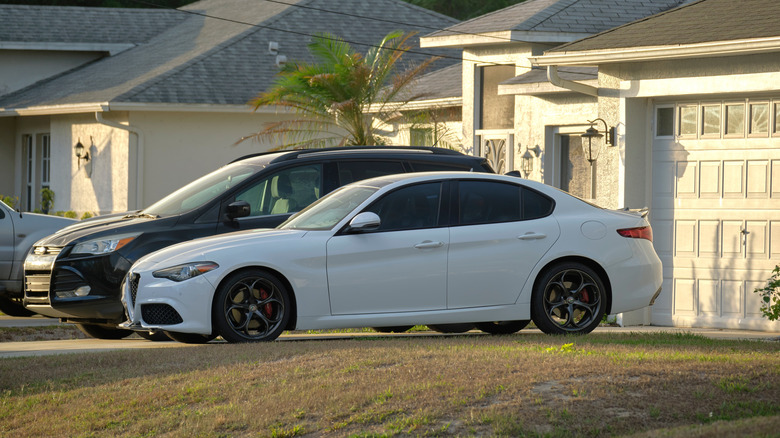Trading In Two Cars For One Can Save You A Ton Of Money
On a rolling basis, car owners across America engage in a time honored practice — they start perusing online listings and visit their local dealerships to size up the market for a new vehicle to get them around town. The average American owns a typical car for roughly eight years, meaning each new purchase opportunity comes in nearly decade-long intervals, if not sooner. Plus, the car buying experience can be one riddled with pitfalls and potential mistakes. It's frequently a good idea to avoid dealer financing if you want to limit the added cost of interest long term (but saying on particular thing upfront when car shopping is an absolute no-no). You'll also want to shy away from buying a brand new car in most instances: It just isn't worth your money.
Among some of the most common strategies when approaching a dealership is a trade-in. Trading your current car in for a new one is practical, allowing you to shed the old vehicle right away. It's also a great way to reduce the financial burden of a new car's purchase price. However, some motorists deploy an additional wrinkle when discussing their trade-in — rather than offering a single vehicle, some will look to part with two cars at once. Not all dealerships will accept this offer, but those that do can help swing the balance in your favor. In fact, there are a few key reasons why trading two cars in when purchasing one new vehicle can help save you tons of money.
Two cars will typically be worth more than one
It's a simple math problem, offering two valuable goods as a trade rather than one will give you more negotiating power as you determine the remaining balance you'll have to pay. The average used car sells for roughly $25,500 in mid-2025, per CarEdge, and trade in values tend to range between $6,000 and around $14,000, depending on age, condition, and other factors. If you're operating based strictly on average figures, a single trade in will drop your out of pocket (or financed) costs down to $16,000. While that takes a nice chunk out of the financial burden of purchasing a new vehicle, a second trade-in vehicle will drop it even lower (by another average figure of $9,500 — down to just $6,500).
A new-to-you ride for that price might be far more attainable when seeking to purchase in all cash. That will eliminate any monthly contributions required from a car financing arrangement, and limit the bleed of a potentially painful interest rate which only serves to add even more to the cost of your purchase. It's important to remember that a two-for-one trade will remove one of your mobility options, but many own more vehicles than they actually need. As of 2022, the average American household owned 1.83 cars. Even so, roughly 10% of Americans rarely or never get behind the wheel. If you have the option to downsize your driveway's accumulation of vehicles, it could be a transformative financial decision, to say the least.
Removing a car from your driveway
There's another financial benefit to utilizing a second car to leverage additional trade-in value. On top of the lump cash price cut you'll enjoy, shedding a car from your household's collection offers a powerful means of reducing other monthly expenses from your ongoing budget calculations. If you don't need the extra car (whether that's your household's second, third, or beyond), it might be a good idea to think about how much it's costing you to sit in the driveway or the garage. On an annual basis, the average cost of bare bones car insurance will run a driver around $800, as of 2025. Then there's the potential for service requirements and other upkeep efforts.
Getting rid of a car you no longer need can easily save you upwards of $1,000 in just the first year alone, in addition to the price reduction you experience when making a new car purchase. This can ultimately serve as a big financial win. That extra cash can go to covering other important features of your home's budget, or it can be a good opportunity to add extra savings for a big purchase or vacation. Eliminating a major expense from your monthly considerations while cashing in on a depreciating asset that will be worth less with each passing year is just good sense. This strategy may not be the best approach for all car buyers, but if it works for your circumstances it can make a huge difference in the transaction and across future budgeting decisions.


